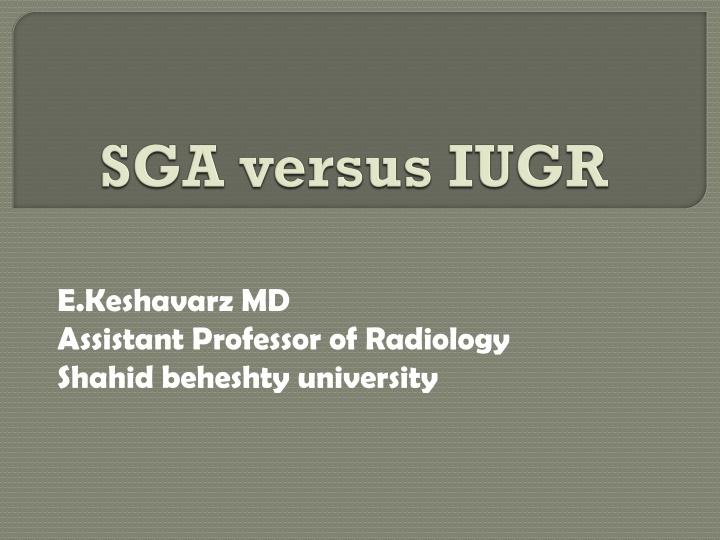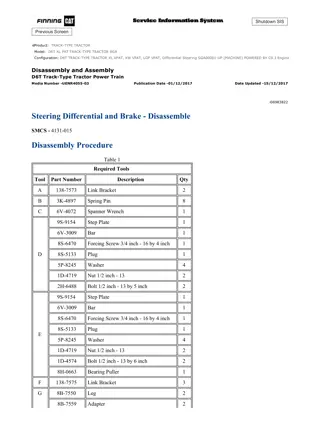
Understanding Fetal Growth Patterns and Implications
Explore the definitions and risks associated with small-for-gestational-age (SGA) babies and intrauterine growth restriction (IUGR), including their impact on perinatal outcomes and long-term health risks. Learn about different categories like SGA, AGA, and more, and how they affect cellular growth and development. Discover the significance of birth weight, growth percentiles, and potential health outcomes for babies at various stages of growth.
Download Presentation

Please find below an Image/Link to download the presentation.
The content on the website is provided AS IS for your information and personal use only. It may not be sold, licensed, or shared on other websites without obtaining consent from the author. If you encounter any issues during the download, it is possible that the publisher has removed the file from their server.
You are allowed to download the files provided on this website for personal or commercial use, subject to the condition that they are used lawfully. All files are the property of their respective owners.
The content on the website is provided AS IS for your information and personal use only. It may not be sold, licensed, or shared on other websites without obtaining consent from the author.
E N D
Presentation Transcript
E.Keshavarz MD Assistant Professor of Radiology Shahid beheshty university
SGA is usually defined as an infant with a birthweight <10th centile for a population or customized standard. IUGR refers to a fetus that has failed to reach its biological growth potential because of placental dysfunction.
Small-for-gestational-age babies make up 28-45% of nonanomalous stillbirths, and have a higher chance of neurodevelopmental delay, childhood and adult obesity, and metabolic disease.
IUGR fetuses have a 6 to 10 fold increased risk of perinatal mortality / 20% still birth Those who survive : 50% have significant short- or long-term intrapartum morbidity : Fetal distress Hypoglycemia Hypocalcemia Meconium aspiration pneumonia Abnormal neurologic development & IVH In Adulthood : Coronary heart disease HTN DM type2- Dyslipidemia Stroke
LOW BIRTH WEIGHT < = 2500gm 1/3 SGA 2/3 Preterm 1/3 IUGR (30%) 2/3Constitutionally ( 70%) IUGR fetuses are usually SGA, but some will be appropriate for gestational age (AGA).
Normal growth on a cellular level is not homogeneous but rather follows a pattern that shift over time from rapid cellular duplication to rapid cellular enlargement. The effects of stimuli that restrict growth may depend in part on when in the sequence of cellular events they occur. Hyperplasia & Hypertrophy 16 32 wk 15 20 g/day Hyperplasia <16 wk Hypertrophy 32 wk 30-35g/day 5 g/day
Very small for gestational age (VSGA; <3rd percentile) Small for gestational age (SGA; <10th percentile) Appropriate for gestational age (AGA; 10th-90th percentile) large for gestational age (LGA; >90th percentile) Up to : Poly or Nl Mild oligo Mod to sev oligo HTN
After 20 weeks gestation a lag of the symphyseal-fundal height of 4 cm (2-3 cm) or more suggests growth restriction.
We failed to identify 90% of SGA with fundal height measurements(Int J Gynaecol Obstet. 2010)
In the case that the LMP is uncertain or not known and early ultrasound (before 13 weeks) has not been performed, ultrasound biometry performed before the 20th gestational week will be associated with a margin of error of 7-10 days. The accuracy of a single US measurement for the detection of GA decrease as gestational ages increases.
The ossification centers of various longs bones are most commonly used in practice. Although their presence does not give an exact GA assessment, it can reassure the clinician that the pregnancy is relatively late into the third trimester . The distal femoral epiphysis is never seen before 28 w, and 100% at 36 w . The proximal tibial epiphysis is never seen before 34 w, and 100% at 39 w. PHE is seen after 37-38 weeks.
combined diameters of the DFE and PTE were > 11 mm and of similar size (DFE greater than or equal to 1mm larger than the PTE) / visible PHE : fetal lung maturity. DFE was seen at 33 weeks in most fetuses often appearing 2-3 weeks earlier in females (29-30 weeks) than males. when the DFE was greater than or equal to 7 mm the gestational age was greater than or equal to 37 weeks. when the PTE was identified, the fetus was at least 35 weeks.
Using the 10th percentiles as cut-offs, the AC has a higher sensitivity (98% vs. 85%) but lower positive predictive value than the SEFW (36% vs. 51%). The fetal AC is related to hepatic glycogen storage and liver size, therefore correlating closely with the nutritional state.
Its sensitivity is further enhanced by serial measurements at least 14 days apart (3 weeks). The recommended interval between ultrasound evaluations of fetal growth is 3 weeks, as shorter intervals increase the likelihood of a false-positive diagnosis.
Fetal growth as opposed to fetal size is a dynamic process. 1-Individualized growth assessment 2-Fetal body proportions
Specially in high-risk pregnancies serial ultrasound evaluations of fetal biometry.
HC/AC TCD/AC FL/AC Although these ratios are associated with small for gestational age at birth and with adverse perinatal outcomes, their predictive accuracy is too low for clinical practice. These ratios are of limited use in determining the etiology underlying fetal smallness.
HC/AC ratio is approximately 1 at 32 to 34 weeks gestation falls below 1 after 34 weeks gestation .
Early responses : loss of 30% of villi hypoxemia-NL PH Late responses : loss of 60-70% of villi acidemia Final
Umbilical artery Doppler studies in suspected small- for-gestational-age pregnancies are universally advised, however there is inconsistency in the recommended frequency for growth scans after diagnosis of small for gestational age/fetal growth restriction (2-4 weekly). In late-onset fetal growth restriction ( 32 weeks) general consensus is to use cerebral Doppler studies to influence surveillance and/or delivery timing.
measurement of the uterine artery pulsatility index (PI) at 11-13 weeks' gestation in combination with maternal history(inc) mean arterial pressure(inc) serum PAPP- A(dec >inc) placental growth factor (PLGF) (dec >inc)
At least four hormone/protein markers measured in the maternal sera during the early second trimester are associated with subsequent IUGR. These include serum estriol, human placental lactogen, human chorionic gonadotrophin, and -fetoprotein (AFP). Elevated MSAFP or hCG levels in the second trimester are considered as markers of abnormal placentation and have been associated with an increased risk for IUGR. second trimester elevated MSAFP, flat oral glucose tolerance, and abnormal second trimester uterine artery Doppler velocimetry as important risk factors for IUGR.
First trimester: decreased PAPP-A & PLGF Second trimester: Increased BHCG/MSAFP and inhibin A decreased estriol
The presence of a normal uterine artery flow velocity waveform bears a high negative predictive value, with a likelihood ratio of 0.5 and 0.8 for the development of preeclampsia and IUGR respectively.






















